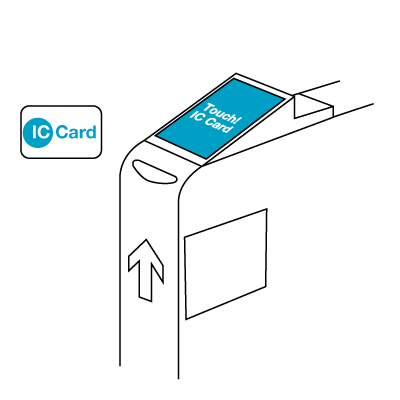|
Sanage Station
is a railway station in the city of Toyota, Aichi, Japan, operated by Meitetsu. Lines Sanage Station is a terminal station of the Meitetsu Mikawa Line and is 21.3 kilometers from the opposing terminus of the line at Chiryū Station. Station layout The station has a single island platform connected to the station building by a level crossing. The station has automated ticket machines, Manaca automated turnstiles and is staffed. Platforms Adjacent stations , - !colspan=5, Nagoya Railroad Station history Sanage Station was opened on October 31, 1924, as a station on the privately owned Mikawa Railway. The line was extended from Sanage to Shidare Station in 1927, and to Nishi-Nakagane Station in 1928. This extension was discontinued on April 1, 2004. The current station building was completed in 1932. The Mikawa Railway was merged with Meitetsu on June 1, 1941. Passenger statistics In fiscal 2017, the station was used by an average of 3988 passengers daily. Surround ... [...More Info...] [...Related Items...] OR: [Wikipedia] [Google] [Baidu] |
Ticket Machine
A ticket machine, also known as a ticket vending machine (TVM), is a vending machine that produces paper or electronic tickets, or recharges a stored-value card or smart card or the user's mobile wallet, typically on a smartphone. For instance, ticket machines dispense train tickets at railway stations, transit tickets at metro stations and tram tickets at some tram stops and in some trams. Token machines may dispense the ticket in the form of a token which has the same function as a paper or electronic ticket. The typical transaction consists of a user using the display interface to select the type and quantity of tickets and then choosing a payment method of either cash, credit/ debit card or smartcard. The ticket(s) are then printed on paper and dispensed to the user, or loaded onto the user's smartcard or smartphone. Ticket and fare formats For most of the twentieth century, ticket machines issued paper tickets, or tokens worth one fare each. Later, fare value ... [...More Info...] [...Related Items...] OR: [Wikipedia] [Google] [Baidu] |
Railway Stations In Aichi Prefecture
Rail transport (also known as train transport) is a means of transport that transfers passengers and goods on wheeled vehicles running on rails, which are incorporated in Track (rail transport), tracks. In contrast to road transport, where the vehicles run on a prepared flat surface, rail vehicles (rolling stock) are directionally guided by the tracks on which they run. Tracks usually consist of steel rails, installed on Railroad tie, sleepers (ties) set in track ballast, ballast, on which the rolling stock, usually fitted with metal wheels, moves. Other variations are also possible, such as "slab track", in which the rails are fastened to a concrete foundation resting on a prepared subsurface. Rolling stock in a rail transport system generally encounters lower friction, frictional resistance than rubber-tyred road vehicles, so passenger and freight cars (carriages and wagons) can be coupled into longer trains. The rail transport operations, operation is carried out by a ... [...More Info...] [...Related Items...] OR: [Wikipedia] [Google] [Baidu] |
Toyota Athletic Stadium
is an athletic stadium in Toyota, Aichi, Japan. The 5000 seat (10,052 m²) all weather sports stadium features an 8 lane 800 metres track for track and natural grass field for soccer or rugby events. The park has numerous other sports venues:http://www.toyota-taikyo.or.jp/undokoen/undo3.html , (Japanese) * softball, slow-pitch and baseball fields * archery field * 200 seat indoor gymnasium * soccer and rugby field See also * List of sports venues with the name Toyota {{Short description, none This is a List of sports venues with the name Toyota. Sports venues with Toyota naming rights * Town Toyota Center, Wenatchee, Washington * Toyota Center, Houston, Texas * Toyota Center, Kennewick, Washington * Toyota F ... References External links Football venues in Japan Sports venues in Aichi Prefecture Sports venues completed in 1987 1987 establishments in Japan Toyota, Aichi {{japan-stadium-stub ... [...More Info...] [...Related Items...] OR: [Wikipedia] [Google] [Baidu] |
Turnstile
A turnstile (also called a turnpike, gateline, baffle gate, automated gate, turn gate in some regions) is a form of gate which allows one person to pass at a time. A turnstile can be configured to enforce one-way human traffic. In addition, a turnstile can restrict passage only to people who insert a coin, ticket, pass, or other method of payment. Modern turnstiles incorporate biometrics, including retina scanning, fingerprints, and other individual human characteristics which can be scanned. Thus a turnstile can be used in the case of paid access (sometimes called a faregate or ticket barrier when used for this purpose), for example to access public transport, a pay toilet, or to restrict access to authorized people, for example in the lobby of an office building. History Turnstiles were originally used, like other forms of stile, to allow human beings to pass while keeping sheep or other livestock penned in. The use of turnstiles in most modern applications has been cr ... [...More Info...] [...Related Items...] OR: [Wikipedia] [Google] [Baidu] |
Manaca
Manaca, written in lower-case letters, is a rechargeable contactless smart card used in Nagoya, Japan and the surrounding area since February 11, 2011, when it replaced the Tranpass magnetic fare card system. As of March 23, 2013, it became compatible with 9 other IC cards, allowing it to be used nationwide. Etymology The name comes from the Japanese word , meaning "center", because Nagoya is roughly in the center of Japan, and because it claims to be a central part of your lifestyle. The name, even in Japanese, is written in Roman letters as "manaca", usually with a lowercase "m". Usage Manaca has a feature set similar to other prepaid IC Cards used across the country. It provides a convenient method of payment for train and bus fares while also being accepted as payment at some shops, restaurants, and vending machines. Manaca cards can be purchased from ticket machines located in subway, city bus and Meitetsu bus and train stations, and are available in both registered ... [...More Info...] [...Related Items...] OR: [Wikipedia] [Google] [Baidu] |
Island Platform
An island platform (also center platform, centre platform) is a station layout arrangement where a single platform is positioned between two tracks within a railway station, tram stop or transitway interchange. Island platforms are popular on twin-track routes due to pragmatic and cost reasons. They are also useful within larger stations where local and express services for the same direction of travel can be provided from opposite sides of the same platform thereby simplifying transfers between the two tracks. An alternative arrangement is to position side platforms on either side of the tracks. The historical use of island platforms depends greatly upon the location. In the United Kingdom the use of island platforms is relatively common when the railway line is in a cutting or raised on an embankment, as this makes it easier to provide access to the platform without walking across the tracks. Advantages and tradeoffs Island platforms are necessary for any station with m ... [...More Info...] [...Related Items...] OR: [Wikipedia] [Google] [Baidu] |
Meitetsu Logomark 2
, referred to as , is a private railway company operating around Aichi Prefecture and Gifu Prefecture of Japan. Some of the more famous trains operated by Meitetsu include the '' Panorama Car'' and the '' Panorama Car Super'', both of which offer views through their wide front windows. While the ''Panorama Super'' train is used extensively for the railroad's limited express service, the older and more energy-consuming ''Panorama Car'' train has been retired, the last run being on 27 December 2008. In the Tōkai region around Nagoya, it is a central firm of the Meitetsu Group, which is involved in the transportation industry, the retail trade, the service industry, and the real estate industry, etc. Meiji Mura is the corporate museum of Meitetsu. As of March 31, 2010, Meitetsu operated of track, 275 stations, and 1,090 train cars. Lines Major stations Major stations in Nagoya *NH36 : Meitetsu Nagoya Station *NH34 : Kanayama Station *NH33 : Jingū-mae Station ... [...More Info...] [...Related Items...] OR: [Wikipedia] [Google] [Baidu] |
Chiryū Station
270px, Platforms is a railway station in the city of Chiryū, Aichi, Japan, operated by Meitetsu. Lines Chiryū Station is served by both the Mikawa Line and Nagoya Main Lines. It is 41.3 kilometers from the terminus of the Nagoya Line at Toyohashi Station and is a terminus of the 39.8 kilometer Mikawa Line. Station layout The station has four island platforms connected by footbridges. The station is staffed. Platforms Adjacent stations History The predecessor Chiryū Station was opened on April 1, 1923, as on the privately owned Aichi Electric Railway Company, but soon merged with nearby on the Mikawa Railway later that year. The Aichi Electric Railway Company was taken over by Meitetsu on August 1, 1935, becoming the Meitetsu Nagoya Main Line, and the Mikawa Railway on June 1, 1941. Shin Chryū Station merged with the Chiryū Station (Main Line Side). A new station was completed on 1 April 1959, and named Chiryū Station, with the former Chiryū ... [...More Info...] [...Related Items...] OR: [Wikipedia] [Google] [Baidu] |
Japan
Japan ( ja, 日本, or , and formally , ''Nihonkoku'') is an island country in East Asia. It is situated in the northwest Pacific Ocean, and is bordered on the west by the Sea of Japan, while extending from the Sea of Okhotsk in the north toward the East China Sea, Philippine Sea, and Taiwan in the south. Japan is a part of the Ring of Fire, and spans an archipelago of 6852 islands covering ; the five main islands are Hokkaido, Honshu (the "mainland"), Shikoku, Kyushu, and Okinawa. Tokyo is the nation's capital and largest city, followed by Yokohama, Osaka, Nagoya, Sapporo, Fukuoka, Kobe, and Kyoto. Japan is the eleventh most populous country in the world, as well as one of the most densely populated and urbanized. About three-fourths of the country's terrain is mountainous, concentrating its population of 123.2 million on narrow coastal plains. Japan is divided into 47 administrative prefectures and eight traditional regions. The Greater Tokyo Ar ... [...More Info...] [...Related Items...] OR: [Wikipedia] [Google] [Baidu] |





